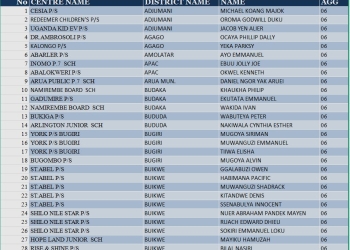She discovered her HIV status recently when a youth-friendly clinic opened near her home in the coastal city of Durban and offered her a test when she went to get contraception. She liked the clinic as it provided her services without making her feel judged, and now helps to educate other teens about HIV and their bodies.
South Africa has one of the highest rates of HIV in the world, and young women bear the brunt of this statistic. Meanwhile, the country’s battle against teen pregnancy was severely undermined by COVID-19 lockdowns and school closures – with spikes in teen pregnancies experienced throughout the continent during the pandemic lockdowns in 2020 and 2021.
South Africa’s most populous province, Gauteng, reported a 60% jump in teen pregnancies between April 2020 and March 2021. More than 23,226 teenagers aged between the ages of 10 and 18 girls gave birth during this period compared to 14,577 girls in the same period a year earlier.
Nkosi told her story at a webinar convened by Clinton Health Access Initiative (CHAI) and Health Systems Trust to discuss how to address teen pregnancy in South Africa.
Describing most teenage pregnancies as “abuse”, CHAI country director Dr Yogan Pillay said that young people in southern Africa had a much higher chance of getting HIV and other sexually transmitted infections as well as mental health problems if they started having sex at an early age.
“Children are also more likely to bear babies born premature, with a lower birth weight and higher neonatal mortality,” added Pillay, former deputy director general of the country’s health department.
“Teenage mothers experience greater rates of postpartum depression and are less likely to initiate breastfeeding. Teenage mothers are less likely to complete high school, more likely to live in poverty and have children who frequently experience health and developmental problems,” he added.
Pillay said that a systematic review of the predictors of teen pregnancies in sub-Saharan Africa found that the most common causes were sexual coercion, low or incorrect use of contraceptives, lack of parental communication and support , low socio-economic status and school dropout.
Addressing these would assist to reduce prevent teen pregnancies, and support teen parents to avoid additional unwanted pregnancies.
Surge in lockdown pregnancies
Many African countries experienced a surge in teen pregnancies during COVID-19 lockdowns and school closures, and concerned health policymakers are struggling to implement effective strategies to curb teen pregnancies.
According to Uganda’s 2016 Demographic and Health Survey, a quarter of girls aged 15-19 years had already experienced a pregnancy. However, teen pregnancies rose by 28% during the first COVID-19 lockdown in 2020, according to the Makerere University School of Public Health. In Uganda’s eastern Busoga sub-region, 45% of deliveries were girls under the age of 17, according to the health ministry.
The Ugandan government’s approach to combatting teen pregnancy has been to promote abstinence-based education in schools. Comprehensive sexuality education has been banned in schools and abortion is illegal.
However, in light of the huge burden of teen pregnancies, some Ugandan parents are demanding more effective sex education in schools and adolescent access to contraception.
Ethiopia, Ghana, Kenya and Zambia have also reported jumps in teen pregnancy thanks to lockdowns. For example, a recent Kenyan study found that girls in Siaya County under the age of 17 who were under lockdown containment measures had double the risk of falling pregnancy and triple the risk of dropping out of school as those who were not under lockdown.
Tackling the problem
UNFPA is spearheading a four-year programme in 10 countries in east and southern Africa called 2gether 4SRHR, with the involvement of UNAIDS UNICEF and the World Health Organization (WHO). Supported by the Swedish International Development Cooperation Agency (SIDA), it aims to improve sexual and reproductive health (SRH) services in the region.
“This includes scaling up client-centred, quality-assured, integrated and sustainable services in SRH, HIV and sexual and gender-based violence, and empowering young people to exercise their SRH rights,” according to UNFPA.
“In many countries in the region, adolescent and young mothers have higher rates of unplanned pregnancies, lower uptake of antenatal and postnatal care, and those living with HIV have poorer adherence to treatment regimens and lower viral load suppression,” according to the UN agency.
“Each week, nearly 3,500 adolescent girls and young women in eastern and southern Africa newly acquire HIV.”
Teen mothers also tend to drop out of school and often never return.

No more pilots
Unlike most other African countries, young South Africans are both able to terminate unwanted pregnancies before 20 weeks and get access to contraception – and neither require their parent’s consent.
However, many teens shun clinics because of the judgemental treatment of healthworkers. For this reason, youth-friendly clinics have long been hailed as one of the solutions to teen pregnancies.
However, Dr Thato Chidarikire, acting chief director of child, youth and school health at the South African health ministry, said lack of resources was a problem.
“Not all primary health care facilities are providing youth-friendly services and have functional, dedicated clinic times for young people. There’s a high turnover of trained personnel and no dedicated resources to support the youth health-focused programmes,” she conceded.
‘Considerable evidence’ of what works
The WHO’s Dr Venkatraman Chandra-Mouli said that there is considerable evidence of successful approaches to reducing adolescent pregnancy.
“What we need are large-scale and sustained programmes. And happily, we now have experiences from a growing number of countries of such programmes,” he said.
“All these programmes had five elements,” according to Chandra-Mouli from the sexual and reproductive health and research unit.
“Firstly, they put scale-up on the national agenda. Secondly, they offered a multi-component intervention package, not just sexual and reproductive services or sexuality education. Thirdly, they put money on the table from internal sources and external sources and managed the scale-up. Fourthly, they built support for the programme and anticipated and addressed resistance when it occurred. And lastly, they worked strategically to ensure sustainability.”
*not her real name

















